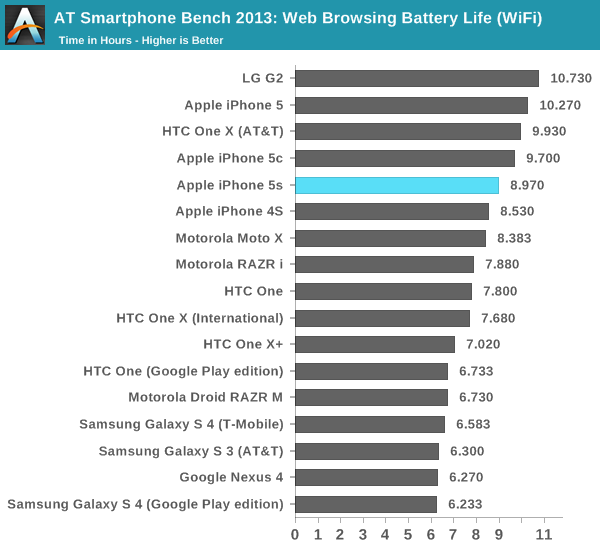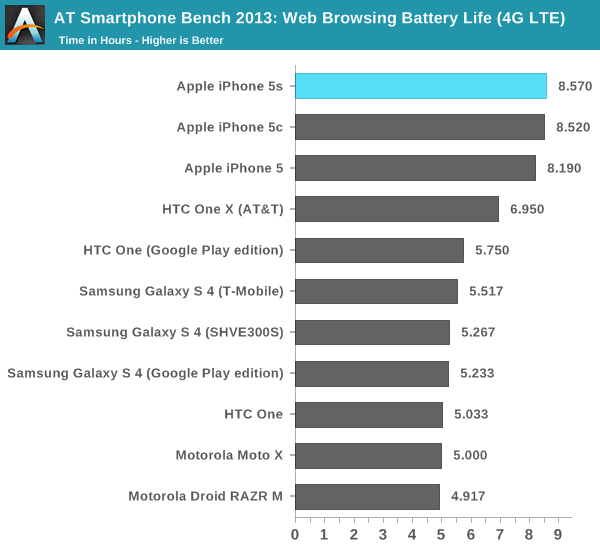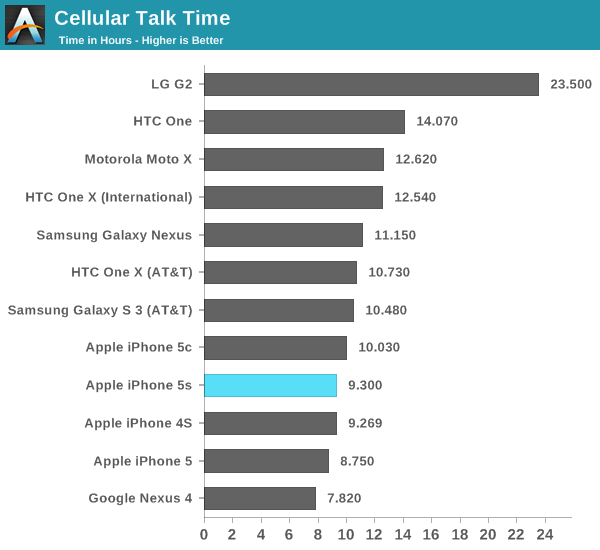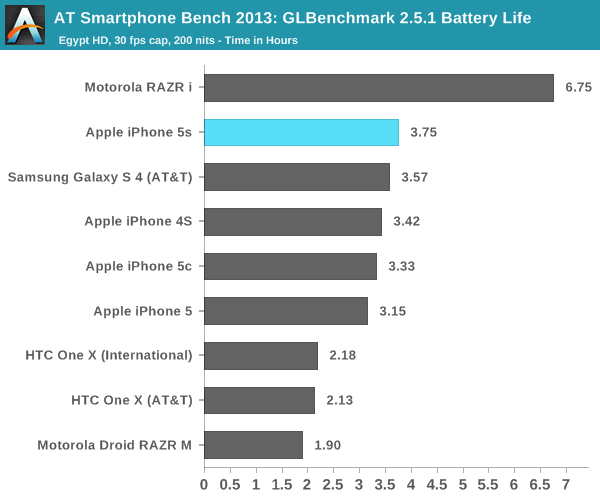The iPhone 5s Review
by Anand Lal Shimpi on September 17, 2013 9:01 PM EST- Posted in
- Smartphones
- Apple
- Mobile
- iPhone
- iPhone 5S
Battery Life
Brian did some excellent sleuthing and came across battery capacities for both the iPhone 5s and 5c in Apple’s FCC disclosures. The iPhone 5 had a 3.8V 5.45Wh battery, while the 5s boosts total capacity to 5.96Wh (an increase of 9.35%). The move to a 28nm process doesn’t come with all of the benefits of a full node shrink, and it’s likely not enough to completely offset the higher potential power draw of a much beefier SoC. Apple claims the same or better battery life on the 5s compared to the iPhone 5, in practice the answer is a bit more complicated.
Unlike previous designs, we’ve never had a half node shrink for an s-SKU. Both the iPhone 3GS and iPhone 4S stayed on the same process node as their predecessor and drove up performance. In the case of the 3GS, the performance gains outweighed their power cost, while in the case of the iPhone 4S we generally saw a regression.
The iPhone 5s improves power consumption by going to 28nm, but turns that savings into increased performance. The SoC also delivers a wider dynamic range of performance than we’ve ever seen from an Apple device. There’s as much CPU power here as the first 11-inch MacBook Air, and more GPU power than an iPad 4.
To find out the balance of power savings vs. additional performance I turned to our current battery life test suite, which we first introduced with the iPhone 5 review last year.
We'll start with our WiFi battery life test. As always, we regularly load web pages at a fixed interval until the battery dies (all displays are calibrated to 200 nits).

The iPhone 5s regresses a bit compared to the 5 in this test (~12% reduction despite the larger battery). We're loading web pages very aggressively here, likely keeping the A7 cores running at their most power hungry state. Even the 5c sees a bit of a regression compared to the 5, which makes me wonder if we're seeing some of the effects of an early iOS 7 release here.
The story on LTE is a bit different. Here we see a slight improvement in battery life compared to the iPhone 5, although the larger battery of the 5s doesn't seem to give it anything other than parity with the 5c:

Our cellular talk time test is almost entirely display and SoC independent, turning it mostly into a battery capacity test:

You can see the close grouping of the smaller iPhones at the bottom of the chart. There's a definite improvement in call time compared to the iPhone 5. We're finally up above iPhone 4S levels there.

Our Egypt HD based 3D battery life test gives us the first indication that Rogue, at least running fairly light code, can be more power efficient than the outgoing 5XT. Obviously the G6430 implemented here can run at fairly high performance levels, so I'm fully expecting peak power consumption to be worse but for more normal workloads there's no regression at all - a very good sign.










464 Comments
View All Comments
BrooksT - Wednesday, September 18, 2013 - link
Nobody will disagree because you've completely destroyed your credibility by insulting the credibility, integrity, and competence of the reviewer, the site, and Apple because the evidence doesn't conform to your speculations and bias. You are not to be taken seriously, and at this point I think everyone sees that.Post evidence of this conspiracy or STFU.
ddriver - Thursday, September 19, 2013 - link
How a whiff of reality for you - my credibility is and has not been on the line on this one. You don't know who I am, you don't know my credentials. This is not the case for Anand, even if I am right he is not in the position to admit to compiling the review in a manner that creates an unrealistically good presentation of a product, because unlike for me, that would be a huge credibility calamity for him. If anything, his responses are very "political" carefully dancing around the pivot points of my concerns. While his response did partially bring light to a few of my concerns, my key points remain valid - the article continues to not compare A7 with ARMv7 head to head in the sole native CPU benchmark present in the article, "CPU performance" was not renamed to JS performance or moved to browser performance or something like that. See, just because he didn't agree with my points and admit to being biased does not mean I am wrong and that is not the case, considering he is not in the position to do that. I didn't really expect anything more or less than the same "carefully dancing" answer as the article itself, my main motivation was to show him that not all AT readers are incapable of reading between the lines, for the sake of future articles, I did not expect that he would make any revision to the article at hand. Honesty is for those who have nothing to lose, and while his credibility is no the line, my isn't, make the conclusions, if you can ;)CyberAngel - Thursday, September 19, 2013 - link
Don't worry! I believe you...conditionally!I put it this way: I greatly doubt that the tests would reveal any points that are less than favorable the Apple. ANY company would do the same: promote the best parts and highlight the strength of the product.
akdj - Thursday, September 19, 2013 - link
"You don't know who I am, you don't know my credentials."I'm not sure anyone here is interested---you've already made clear you're a conspiracy theorist, that you believe Apple is paying off reviewers, that you disrespect folks MUCH more intelligent than yourself when it comes to chip architecture...and that your "main motivation was (Is) to show him that not all AT readers are incapable of reading between the lines". You've shown NO one ANYthing substantiated. You continue to argue baseless facts and accuse respected individuals and groups/teams of intelligent members of being bias towards Apple. Nothing in this review supports your claims---NOTHING! And, as I pointed out earlier---even the biggest anti-apple sites are applauding Apple's efforts with this SoC effort.
You're in the minority---and to be so vain that we would care about who you are and what your credentials are is silly. It sounds to me like you're a 17 year old with a decent vocabulary and not enough paper in the pocket to pick up an iPhone 5s for yourself. But...what do I know. I don't know you, your credentials...or how you lean politically, nor do I care.
IMO---you're an insult to the entire Anand crew. I'm not sure why I continue to read your responses, they're all the same, just worded differently. Again...you're in the (extreme) minority. You're certainly not an engineer, chip designer, app developer or technological guru---if you were, you would understand the feat Apple has achieved with this SoC architecture.
J
Nurenthapa - Friday, September 20, 2013 - link
I've been enjoying reading this in China, but you, sir, are really annoying me with your sniveling drivel. You have an axe to grind and simply won't shut up. Hope you disappear from this forum. BTW, I use a HTC One and iPad 2, and occasionally my old original 2007 iPhone. I love IOS and iPhones, but won't be buying one until they come out with a somewhat bigger screen.oryades - Wednesday, September 18, 2013 - link
Intel, now Apple, the same featured reviews.edward kuebler - Wednesday, September 18, 2013 - link
We are talking about 64 bits too much. The story is new instruction set in ARMv8. Instead complicating the hardware for backwards compatibility (e.g. look at x86 still supporting 16bit code) they wrote a new instruction set faster and less energy demanding. There is still ARMv7 compatibility, but the 64bit mode is independent. And the thing is, once you redesign your architecture, why not go 64bit? what´s the point of staying 32 bit? Moving more data is both slower and faster. More and wider registers help compiler optimizations and media decoding. I didn't get all this “cunning deceitful conspiracy” feeling you talk about. Staying in 32 bit land, *that* would keep me guessing.Anand Lal Shimpi - Wednesday, September 18, 2013 - link
Our browser based suite (stressing js/HTML5 and other browser based workloads) remains unchanged from all of the other mobile SoC reviews we've done. There's no way of getting around the software differences on these mobile devices as you buy hardware+software together. Unfortunately it's still our best option for non-GPU cross platform comparisons, there just aren't many good cross platform CPU tests.I called out the inclusion of hardware accelerated AES/SHA when referencing those tests, there were no attempts to hide that fact. The fact remains that those algorithms will see a speedup on ARMv8 hardware because of those instructions. Note this is no different than when we run the TrueCrypt benchmarks on AES-NI enabled processors vs. those that don't have it (e.g. http://images.anandtech.com/graphs/graph5626/44765...
Apple provided absolutely zero guidelines on how the review was to be conducted. The only stipulations were around making sure we didn't disclose the fact that we had devices. In fact, most manufacturers don't - at least not with us. Whenever there are any stipulations presented, we always disclose them on the site (e.g. see our early look at Trinity desktop performance).
Krait implements ARMv7, so that's 64-bit wide registers for its NEON units. It expanded the width of the execution units, but the registers themselves have to adhere to the ARMv7 ISA.
I think we explained why 64-bit makes sense (doing so at the last minute doesn't make sense, immediate SIMD/Crypto perf increases today, and helps build up the ecosystem), and even highlighted cases where a performance degradation does happen (see: Dijkstra tests). Keep in mind that iOS has always erred on the side of being more thrifty with RAM to begin with. I would like to see more but I don't know how necessary it is today.
Take care,
Anand
ddriver - Wednesday, September 18, 2013 - link
Anand, maybe you should hire a developer to write native cross platform benchmark tools. This is the only way to avoid all caveats like sponsored exclusive optimizations, different implementations, eliminate unrealistic low footprint synthetics, "selective compilers" (*cough Intel*) and whatnot. Considering the amount of reviews you are doing and the fact that C/C++ compilers have caught up with ARM for a long time, this is nothing hard and something that entirely makes sense, especially relative to using different JS engine implementations to measure CPU performance. JS should go in the "browser" department, not CPU performance.According to wikipedia, Krait implements 128bit SIMD, so maybe that is a mistake on wikipedia's behalf?
I still think encryption results belong in their own chart, and have no place in a chart that is supposed to be indicative of the integer performance delta between 32 and 64bit execution modes. Even with the clarification you made, it creates an unrealistic impression, not to mention some people skimp over the text and only look at the numbers. Encryption is encryption, integer performance is integer performance. Why mix the two (except for the reason I already mentioned and you deny)?
I wish you'd reflected a bit on the marketing aspect of the transition to 64, considering how much apple is riding it this time around. No one argues 64bit is good and more performance is good, but this brings up the issue of the particular implementation, e.g. a fast chip with only a single gigabyte of ram, and how will that play out with an actual performance demanding real world application.
Thanks for addressing my concerns.
Wilco1 - Wednesday, September 18, 2013 - link
ARMv7 has 32 64-bit SIMD registers but they can also be used as 16 128-bit SIMD registers. Modern CPUs like Cortex-A15 and Krait support many 128-bit SIMD operations in a single cycle, but not all operations are supported (such as double precision FP). ARMv8 has 32 128-bit SIMD registers and supports SIMD of 2 64-bit doubles.